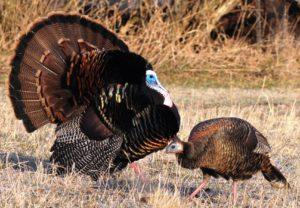Photography courtesy of Lowell Washburn, all rights reserved.
Mature Gobblers Spend Around Four Months of Their Year in the Strut.
So why do birds expend so much time and energy in display? Is it to guard territory or attract hens? The answer may come as a surprise.
Calling a spring gobbler into close range is one of hunting’s most rewarding challenges. With tail fanned and wings dragging, there are few sights more spectacular than when a strutting tom comes marching in. But although a strutting gobbler represents an awe inspiring sight, hunters often misinterpret the real purpose of this dramatic display.
One of the most commonly held misconceptions is that strutting, along with fighting, is designed to aid a gobbler in defending its territory. This notion is patently incorrect because wild turkeys do not have territories. Birds like robins, peregrine falcons, and Canada geese have territories. Wild turkeys do not.
Precisely outlined by invisible boundaries, avian territories are distinct plots of real estate that are vigorously defended against all comers. By contrast, wild turkeys do no live within clearly mapped territories. Instead, they occupy general home ranges. A home range is wherever a turkey makes its living. A gobbler’s winter range may be located miles from where the same bird will be found during the spring and summer. This is especially true for the Merriam’s turkeys I’ve hunted in the western Black Hills where birds gather into enormous flocks at lower elevation ranches during winter and then disperse back into the Hills at snow melt. The difference between turkeys and birds that hold territories is that once the spring breeding season arrives, turkeys do not claim and protect specifically defined areas.
The reason strutting gobblers frequently engage in spectacular fighting is not to claim or defend breeding territory but rather to exert dominance. For wild turkeys, the struggle for dominance is a lifelong endeavor. It begins when the bird is a young poult and ultimately ends with the turkey’s death. While bow hunting, I’ve had groups containing up to seven mature toms strut to within feet of my position. Upon shooting the dominant bird, I’ve watched in amazement as the survivors instantly turned on their fallen comrade, making a group project of stomping their former boss into the sod. It appears that a turkey’s political loyalties are not all different from our own.
Another commonly held belief is that strutting attracts hens. This is also false, or at least mostly so. In reality, toms attract hens by gobbling – either from the roost or on the ground. Under ideal conditions spring gobbling can be heard for miles. If it’s the closest game in town, hens will travel to the sound. Once hens arrive on the scene, gobblers use the strut to display and exaggerate their finery. This brings us to the real purpose of the strut, which is to show off and make an individual tom more attractive to females. Sometimes a dominate gobbler will allow other males to strut. Sometimes they don’t. But whenever multiple strutters are present within a group, rest assured that each and every bird knows which turkey is king.
Final Thought: Do hens strut? The answer is yes. But the event is extremely rare and is done for much different reasons than when a gobbler struts. In nearly 40 years of observing and hunting wild turkeys, I’ve only witnessed three occasions where hens displayed an all-out tail fanned, wings dragging strut. I’ve seen hens go into full strut twice during early spring and once in January. On all three occasions the birds were mature, Alpha-hens responding to an ultra-realistic DSD hen decoy. In all three cases, the birds became highly agitated at first sight of the “unknown hen” and were eager to let the stranger know who was in charge. After emitting a prolonged series of “fighting purrs”, each strutting hen vigorously attacked the decoy. One bird even went so far as making a serious attempt to completely engulf the decoy’s head with her beak [photo below]. When a hen struts, the message is clear. The display is not designed to show off, appear more desirable, or to attract other birds. Instead, its singular purpose is to communicate dominance over another hen.




 Susan Judkins Josten
Susan Judkins Josten Rudi Roeslein
Rudi Roeslein Elyssa McFarland
Elyssa McFarland Mark Langgin
Mark Langgin Adam Janke
Adam Janke Joe Henry
Joe Henry Sue Wilkinson
Sue Wilkinson Tom Cope
Tom Cope Kristin Ashenbrenner
Kristin Ashenbrenner Joe Wilkinson
Joe Wilkinson Dr. Tammy Mildenstein
Dr. Tammy Mildenstein Sean McMahon
Sean McMahon